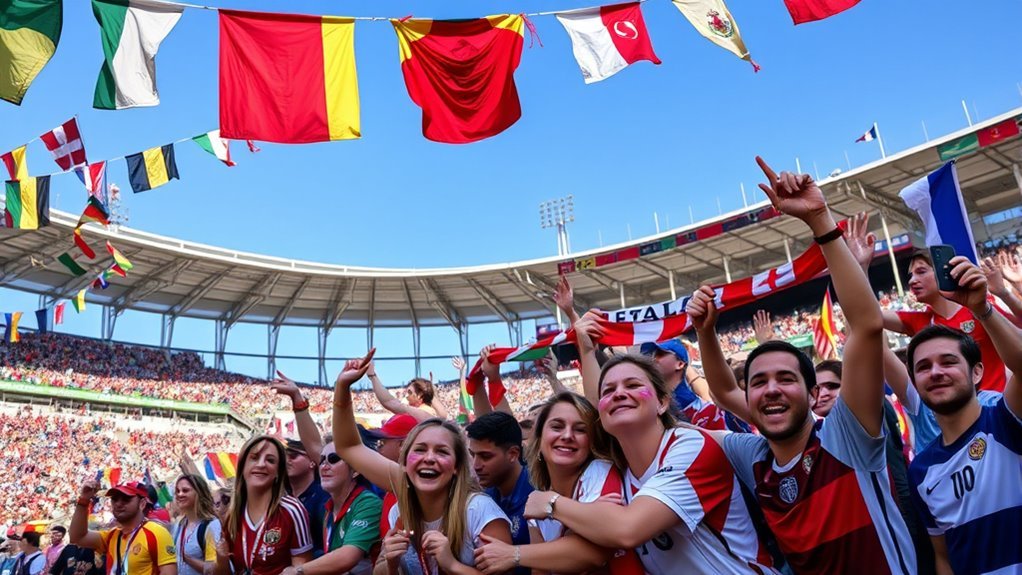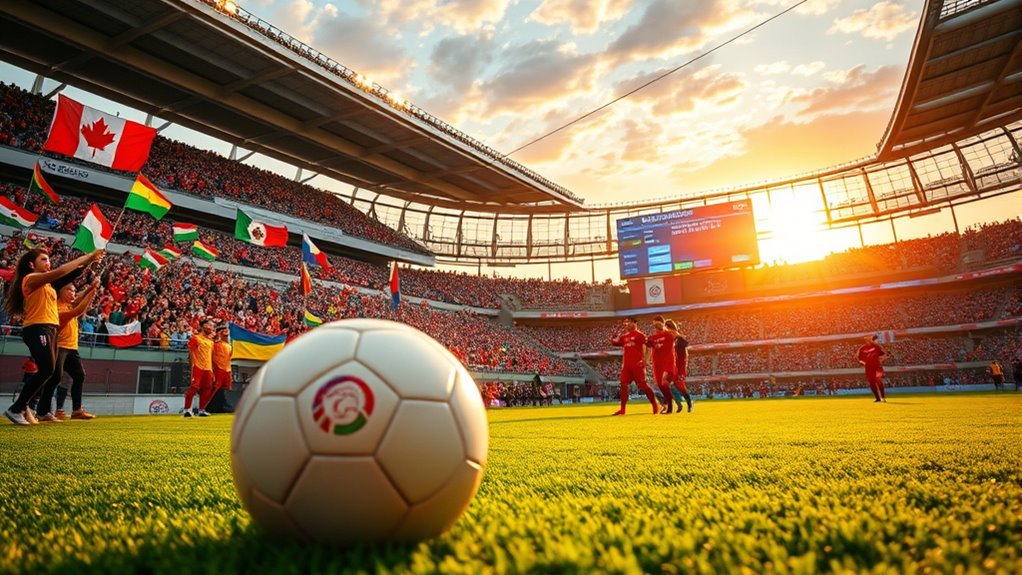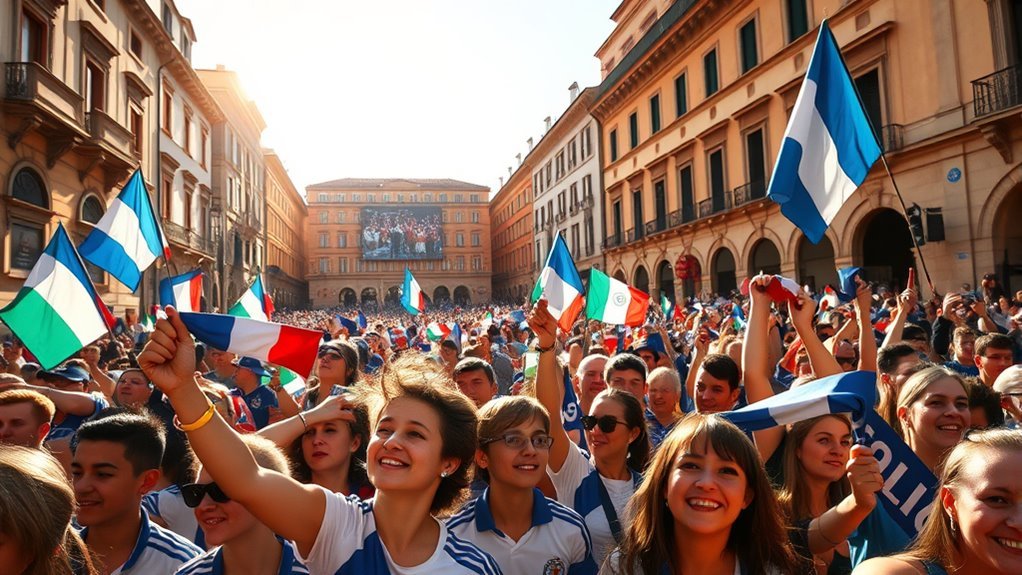As of now, Brazil, Germany, Argentina, and France have secured their spots for the FIFA World Cup 2026. This tournament is particularly exciting as it expands from 32 to 48 teams and is hosted collaboratively by the United States, Canada, and Mexico. Nations are competing fiercely for remaining spots, with underdogs poised to make their mark. If you’re curious about which teams might qualify next, there’s more to discover about this thrilling event.
Overview of FIFA World Cup 2026
As the excitement builds for the FIFA World Cup 2026, you’ll find this tournament promises to be unlike any other, featuring an expanded format with 48 teams instead of the traditional 32. This change reflects FIFA’s commitment to inclusivity, giving more nations the chance to showcase their talent on the world stage. With more teams come heightened tournament expectations, and fans can’t wait to see how this will impact the competition.
Historically, the World Cup has united nations and cultures, celebrating the beautiful game. The 2026 edition aims to elevate that spirit of freedom and camaraderie. Each match will be a chance for underdogs to shine and for established teams to maintain their legacies. You’ll witness diverse playing styles and passionate fans, all contributing to a vibrant atmosphere. This tournament could redefine FIFA history, making it a landmark event for soccer lovers everywhere. Get ready for an unforgettable experience!
Host Nations: United States, Canada, and Mexico
The 2026 FIFA World Cup will be unique not just in its format, but also in its hosting arrangements, as it marks the first time three nations—United States, Canada, and Mexico—will collaboratively host the tournament. This unprecedented partnership brings together diverse cultures and passionate soccer fans, creating a vibrant atmosphere.
Stadium preparations across these countries are already underway, ensuring that venues meet the highest standards for an unforgettable experience. From iconic stadiums in the U.S. to the passionate soccer culture in Mexico and the growing enthusiasm in Canada, each host nation contributes its unique flair.
Fan engagement will also play a significant role. Organizers are focusing on innovative ways to connect with fans, allowing everyone to immerse themselves in the festivities, whether they’re at the games or enjoying the action from their homes. This World Cup promises to be a celebration of freedom, unity, and the beautiful game.
Expansion of Teams From 32 to 48
With the expansion from 32 to 48 teams, you’ll see a broader range of nations represented at the FIFA World Cup. This shift not only changes the tournament’s format and structure but also impacts how qualifying teams prepare and compete. It’s an exciting time for global football, and the implications are huge.
Increased Global Representation
While expanding the FIFA World Cup from 32 to 48 teams might seem like a simple increase in numbers, it actually marks a significant shift in the tournament’s approach to global representation. This expansion opens the door for more nations to showcase their passion for the beautiful game, celebrating global diversity like never before.
Here are some key benefits:
- More countries can experience the thrill of competition.
- Fans from diverse backgrounds unite in celebration.
- Lesser-known football nations can inspire future generations.
- It fosters football growth across all continents.
Format and Structure Changes
Expanding the World Cup to 48 teams not only enhances global representation but also introduces significant changes to the tournament’s format and structure. You’ll notice the format changes will allow for 16 groups of three teams each, rather than the traditional four. This shift means each team will play two matches in the group stage, with the top two from each group advancing. The knockout stage will then feature 32 teams, providing a thrilling climax to the tournament. These structure revisions aim to keep excitement high while ensuring more nations can participate. Ultimately, this new format not only celebrates the spirit of competition but also embodies the freedom of nations to showcase their talents on the world stage.
Impact on Qualifying Teams
As the World Cup expands from 32 to 48 teams, the impact on qualifying teams is profound. This change opens new doors, allowing more nations to bask in the glory of competition, igniting a sense of national pride that’s simply contagious. Here are some qualification benefits you can expect:
- Increased Opportunities: More teams mean more chances for all nations to shine.
- Diverse Representation: A broader range of countries showcases the global spirit of football.
- Enhanced Fan Engagement: Fans can rally behind their teams, fostering unity and excitement.
- Historic Moments: Underdogs can create unforgettable stories, capturing hearts worldwide.
This expansion isn’t just about numbers; it’s about freedom, hope, and the beautiful game uniting us all.
Qualification Process for Teams
When it comes to the qualification process for the FIFA World Cup 2026, you’ll find it more complex with the expanded number of teams. Understanding the various stages of qualification and how each confederation participates is essential. Let’s break down how teams from around the world will earn their spots in this historic tournament.
Qualification Stages Overview
The qualification process for the FIFA World Cup 2026 is designed to guarantee that only the best teams from around the globe make it to the tournament. You’ll see nations employing various qualification strategies through regional competitions, battling for their chance to shine on the world stage. Here’s what to expect:
- Intense Matches: Teams will face fierce rivals, pushing their limits.
- Dramatic Upsets: Underdogs can surprise and steal the spotlight.
- Passionate Fans: Supporters rally behind their teams, igniting national pride.
- Dreams Realized: Players chase their dreams, fighting for a spot in history.
This journey is about more than just football; it’s a quest for freedom and glory. Get ready for an exhilarating ride!
Confederation Participation Breakdown
While each confederation has its unique qualification process, they all share a common goal: securing a place in the FIFA World Cup 2026. Understanding confederation history and team rankings can give you insight into how teams vie for these coveted spots.
Here’s a breakdown of participation by confederation:
| Confederation | Teams Qualified | Qualification Format |
|---|---|---|
| UEFA | 16 | Group Stage Matches |
| CONMEBOL | 6 | Round-robin Format |
| CONCACAF | 6 | Hexagonal Round |
Each confederation’s approach reflects its competitive spirit, allowing teams to showcase their talent. As you follow this journey, remember the excitement and freedom that come with every match played.
Current Qualified Teams
As of now, several teams have secured their spots for the FIFA World Cup 2026, setting the stage for an exciting tournament. The current standings highlight some outstanding team performances that have truly captured the hearts of fans worldwide. Here are four teams that’ve made it through:
- Brazil – Always a contender, their flair and passion are unmatched.
- Germany – Known for their discipline, they’re ready to reclaim glory.
- Argentina – With a rich history, they’re bringing the fire again.
- France – The reigning champions, they aim to defend their title with style.
Each of these teams represents not just skill but the dreams of millions. As we watch the journey unfold, the anticipation grows for a tournament that promises to celebrate the beautiful game and the freedom it brings to fans everywhere.
Teams in Contention for Qualification
With 32 spots available for the FIFA World Cup 2026, numerous teams are still battling for their chance to qualify. Among them, you’ll find regional powerhouses like Mexico and the United States, who’ve consistently shown strength in previous tournaments. But don’t overlook potential darkhorses like Canada and Costa Rica, who could shake things up and surprise everyone.
Other nations are also in the fray, enthusiastic to seize their moment on the world stage. Teams from Africa and Asia are looking to make their mark, showcasing emerging talent and determination. You might even see some underdogs rise through the ranks, proving that with hard work and strategy, anything’s possible.
As the qualification rounds unfold, the excitement builds. Each match could shift the landscape, and every team knows that a single victory might be the key to fulfilling their dreams of World Cup glory.
Key Matches to Watch
Which matches will be pivotal in shaping the qualification landscape for the FIFA World Cup 2026? It’s not just about the teams; it’s about the stories, the passion, and the thrilling rivalries that define football. Here are four key matchups you won’t want to miss:
- USA vs. Mexico – This classic rivalry always delivers high stakes and intense emotions.
- Brazil vs. Argentina – The South American clash is a showcase of skill and national pride.
- Italy vs. Germany – Two footballing giants collide, and you can feel the history in every play.
- Spain vs. France – A battle of styles that will keep you on the edge of your seat.
These moments could define nations and create unforgettable memories. As the matches unfold, you’ll witness the true essence of freedom in sport—the joy, the heartbreak, and the sheer thrill of competition!
Historical Performance of Qualified Teams
When you look at the historical performance of teams that have qualified for the FIFA World Cup 2026, you’ll notice distinct patterns that reveal their strengths and weaknesses on the international stage. Teams like Brazil and Germany boast rich legacies, showcasing consistent success and resilience. Their historical trends illustrate a knack for thriving under pressure, often advancing deep into tournaments.
Conversely, some nations have struggled to translate potential into performance, frequently falling short despite strong squads. This dichotomy highlights the unpredictability of the tournament, where team legacies can shift dramatically from one World Cup to the next.
As you analyze these qualified teams, consider how past performances shape expectations and inspire future ambitions. Each match presents an opportunity for redemption or glory, reminding us that history is not just a backdrop but a driving force in the quest for World Cup success.
Impact of Qualification on National Teams
Although qualifying for the FIFA World Cup 2026 is a significant achievement, it also brings immense pressure and expectations for national teams. This moment is a catalyst for growth, but it can also weigh heavy on players and coaches alike. Here’s how this qualification impacts them:
Qualifying for the FIFA World Cup 2026 ignites national pride but also brings pressure that challenges players and coaches alike.
- National Pride: Fans rally behind their teams, creating a powerful atmosphere that can elevate performance.
- Team Development: Coaches must harness this momentum to build stronger, more cohesive units for future competitions.
- Visibility: Players gain international exposure, potentially opening doors to lucrative opportunities abroad.
- Pressure: With high expectations comes immense scrutiny, which can either motivate or overwhelm teams.
Navigating these dynamics isn’t easy, but it’s essential for fostering resilience and unity. In the end, the journey toward the World Cup can redefine a nation’s football identity, fueling dreams of freedom and success.
Frequently Asked Questions
How Many Teams Will Participate in the FIFA World Cup 2026?
There’ll be 48 teams participating in the FIFA World Cup 2026 due to team expansion. The qualification criteria will allow more nations a chance to showcase their talent, bringing more excitement and freedom to the tournament.
What Are the Dates for the FIFA World Cup 2026?
You’ll want to mark your calendar, as the FIFA World Cup 2026 kicks off from June 8 to July 8. It’s a month-long tournament schedule to celebrate the beautiful game and your love for it!
How Will the New Qualification Format Work?
The new qualification format’ll include expanded slots based on regional allocations. You’ll see varying qualification criteria, giving more countries a chance. It’s all about embracing the spirit of competition and freedom for nations worldwide.
Which Cities Will Host Matches in the United States?
You’ll enjoy matches in cities like Los Angeles, New York, and Miami, each boasting impressive stadium capacities. These venues promise an unforgettable fan experience, blending thrilling soccer action with the vibrant culture of their locations.
What Is the History of the FIFA World Cup?
You’ve gotta love how the World Cup’s evolved! From legendary players like Pelé to historical highlights that make you weep, it’s a glorious showcase of sport, trends, and a dash of drama. Buckle up!




